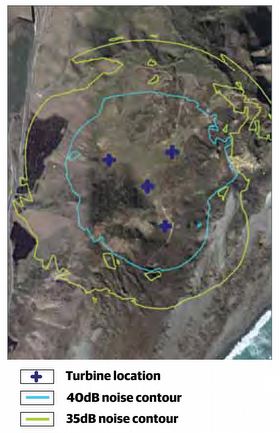NZS 6808:2010 provides suitable methods for the prediction, measurement and assessment of sound from wind farms that takes into account the factors that are specific to that sound. It also recommends limits on the level of sound that can be heard from locations near wind farms.
It is used by wind farm developers, acoustics specialists, councils and others involved in setting and monitoring wind farm noise limits in resource consent conditions.
The noise limits recommended in the Standard are intended to provide protection against sleep disturbance and maintain a reasonable amenity at locations surrounding a wind farm.
People living near a wind farm may still hear the wind farm at times, but if the limits recommended in the Standard are properly applied the level of sound will not be unreasonable or out of place with other sounds in the environment. This approach is consistent with how sound from other sources is managed, such as from ports and airports.
How quiet must a wind farm be?
NZS 6808:2010 recommends that the level of sound from a wind farm, when heard from outside a home, should not exceed the background sound level by more than 5 decibels (dB), or a level of 40 dB, whichever is the greater. In special circumstances for particularly quiet locations, the Standard recommends a lower, more stringent limit during the evening and night time of 35 dB or 5 dB more than the background sound level, whichever is the greater.
 People living near a wind farm may hear the wind farm at times, but the limits recommended in the Standard are intended to provide protection against sleep disturbance and maintain a reasonable amenity at locations surrounding a wind farm. Recommendations in the Standard are based on the World Health Organisation's guideline noise limit of 30 dB inside bedrooms to prevent sleep disturbance. This equates to the noise limit in the Standard of 40 dB outside, as sound attenuates – or become quieter – as it travels through walls and windows.
People living near a wind farm may hear the wind farm at times, but the limits recommended in the Standard are intended to provide protection against sleep disturbance and maintain a reasonable amenity at locations surrounding a wind farm. Recommendations in the Standard are based on the World Health Organisation's guideline noise limit of 30 dB inside bedrooms to prevent sleep disturbance. This equates to the noise limit in the Standard of 40 dB outside, as sound attenuates – or become quieter – as it travels through walls and windows.
To put the sound levels for wind farms into context, 40 dB is typical of a quiet residential area with only light traffic and natural sounds such as the wind in the trees. In contrast, sound levels along-side an urban road would be around 60 to 70 dB during the day and about 50 to 60 dB at night.
Development of the Standard
The Standards New Zealand committee that developed the Standard included representatives of local authority and community interests, engineering and scientific experts in acoustics, practitioners in planning, resource management and environmental health and wind farm developers.
The representatives were nominated by:
- Energy Efficiency and Conservation Authority
- Executive of Community Boards
- Local Government New Zealand
- Massey University
- Ministry for the Environment
- Ministry of Health
- New Zealand Acoustical Society
- New Zealand Institute of Environmental Health Inc.
- New Zealand Wind Energy Association
- Resource Management Law Association
- University of Auckland.
Find out more:
- NZWEA factsheet on the New Zealand Wind Farm Noise Standard
- Standards New Zealand website
- NZS 6808:2010 Acoustics – Wind farm noise, Dr Stephen Chiles, NZ Acoustics, Vol 23 No 2. Published by the New Zealand Acoustical Society.
